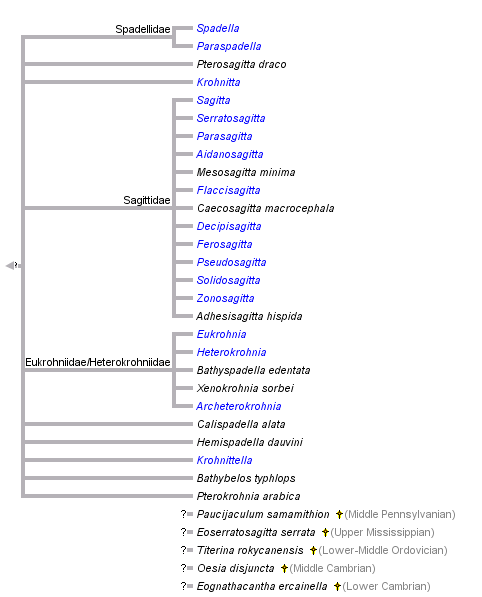Chaetognatha
Arrow Worms



This tree diagram shows the relationships between several groups of organisms.
The root of the current tree connects the organisms featured in this tree to their containing group and the rest of the Tree of Life. The basal branching point in the tree represents the ancestor of the other groups in the tree. This ancestor diversified over time into several descendent subgroups, which are represented as internal nodes and terminal taxa to the right.

You can click on the root to travel down the Tree of Life all the way to the root of all Life, and you can click on the names of descendent subgroups to travel up the Tree of Life all the way to individual species.
For more information on ToL tree formatting, please see Interpreting the Tree or Classification. To learn more about phylogenetic trees, please visit our Phylogenetic Biology pages.
close boxReferences
Ball, E. E. and D. J. Miller. 2006. Phylogeny: The continuing classificatory conundrum of chaetognaths. Current Biology 16(15):R593-R596.
Bieri, R. 1991. Systematics of the Chaetognatha. Pages 122-136 in: The Biology of Chaetognaths. Q. Bone Q, H. Knapp, and A. C. Pierrot-Bults, eds. Oxford University Press, Oxford
Bieri, R. and E. V. Thuesen. 1990. The strange worm Bathybelos. American Scientist 78:542–549.
Bone, Q., H. Knapp, and A. C. Pierrot-Bults, eds. 1991. The Biology of Chaetognaths. Oxford University Press, Oxford.
Casanova, J.-P. 1985. Description de l'appareil génital primitif du genre Heterokrohnia et nouvelle classification des Chaetognathes. Compte-rendus hebdomadaires des Séances de l'Academie des Sciences, Paris, Ser. 3, 301:397-402.
Chen, J.-Y. and D.-Y. Huang. 2002. A possible Lower Cambrian chaetognath (arrow worm). Science 298:187.
Doguzhaeva, L. A., H. Mutvei, and R. H. Mapes. 2002. Chaetognath grasping spines from the Upper Mississippian of Arkansas (USA). Acta Palaeontologica Polonica 47(3):421–430.
Halanych, K. M. 1996. Testing hypotheses of chaetognath origins: long branches revealed by 18S ribosomal DNA. Systematic Biology 45:223–246.
Helfenbein, K. G., H. M. Fourcade, R. G. Vanjani, and J. L. Boore. 2004. The mitochondrial genome of Paraspadella gotoi is highly reduced and reveals that chaetognaths are a sister group to protostomes. Proceedings of the National Academy of Sciences 101(29):10639-10643.
Kapp, H. 2000. The unique embryology of Chaetognatha. Zoologischer Anzeiger 239:263-266.
Marletaz, F., E. Martin, Y. Perez, D. Papillon, X. Caubit, C. Lowe, B. Freeman, L. Fasano, C. Dossat, P. Wincker. 2006. Chaetognath phylogenomics: A protostome with deuterostome-like development. Current Biology 16: R577–578.
Matus, D. Q., R. R. Copley, C. W. Dunn, A. Hejnol, H. Eccleston, K. M. Halanych, M. Q. Martindale, and M. J. Telford. 2006. Broad taxon and gene sampling indicate that chaetognaths are protostomes. Current Biology 6:R575576.
Papillon, D., Y. Perez, X. Caubit, and Y. Le Parco. 2006. Systematics of Chaetognatha under the light of molecular data, using duplicated ribosomal 18S DNA sequences. Molecular Phylogenetics and Evolution 38(3):621-634.
Salvini-Plawen, L. W. 1986. Systematics notes on Spadella and on the Chaetognatha in general. Z. Zool. Syst. Evol. 24:122–128.
Schram, F. R. 1973. Pseudocoelomates and a nemertine from the Illinois Pennsylvanian. Journal of Paleontology 47:985–989.
Shinn, G. L. 1997. Chaetognatha. Pages 103-220 in: Microscopic Anatomy of Invertebrates. Vol. 15. F. W. Harrison and E. E. Ruppert, eds. Wiley-Liss, New York.
Shinn, G. L. and M. E. Roberts. 1994. Ultrastructure of hatching chaetognaths (Ferosagitta hispida): phylogenetic implications. Journal of Morphology 219:143-163.
Szaniawski, H. 2002. New evidence for the protoconodont origin of chaetognaths. Acta Palaeontologica Polonica 47(3):405–419.
Szaniawski, H. 2005. Cambrian chaetognaths recognized in Burgess Shale fossils. Acta Palaeontologica Polonica 50(1):1-8.
Tokioka, T. 1965. The taxonomical outline of Chaetognatha. Publications of the Seto Marine Biological Laboratory 12:335-357.
Telford, M. J. 2004. Affinity for arrow worms. Nature 431:254-256.
Telford, M. J., and P. W. H. Holland. 1993. The phylogenetic affinities of the chaetognaths: A molecular analysis. Molecular Biology and Evolution 10:660-676.
Telford, M. J. and P. W. H. Holland. 1997. Evolution of 28S ribosomal DNA in chaetognaths: duplicate genes and molecular phylogeny. Journal of Molecular Evolution 44:135-144.
Information on the Internet
- Chaetognatha. Erik V. Thuesen, Evergreen State College, Olympia, Washington.
- Chaetognatha of the World. A. Pierrot-Bults, Zoological Museum, University of Amsterdam.
- The Chaetognath, a strange creature. Micscape magazine article by Jean-Marie Cavanihac.
- A bioluminescent chaetognath. S. H. D. Haddock and J. F. Case
Title Illustrations

| Scientific Name | Spadella |
|---|---|
| Creator | J. M. Cavanihac |
| Copyright |
© BIODIDAC

|
About This Page
Page copyright © 2002
 Page: Tree of Life
Chaetognatha. Arrow Worms.
The TEXT of this page is licensed under the
Creative Commons Attribution-NonCommercial License - Version 3.0. Note that images and other media
featured on this page are each governed by their own license, and they may or may not be available
for reuse. Click on an image or a media link to access the media data window, which provides the
relevant licensing information. For the general terms and conditions of ToL material reuse and
redistribution, please see the Tree of Life Copyright
Policies.
Page: Tree of Life
Chaetognatha. Arrow Worms.
The TEXT of this page is licensed under the
Creative Commons Attribution-NonCommercial License - Version 3.0. Note that images and other media
featured on this page are each governed by their own license, and they may or may not be available
for reuse. Click on an image or a media link to access the media data window, which provides the
relevant licensing information. For the general terms and conditions of ToL material reuse and
redistribution, please see the Tree of Life Copyright
Policies.
- Content changed 06 September 2006
Citing this page:
Tree of Life Web Project. 2006. Chaetognatha. Arrow Worms. Version 06 September 2006 (temporary). http://tolweb.org/Chaetognatha/2478/2006.09.06 in The Tree of Life Web Project, http://tolweb.org/







 Go to quick links
Go to quick search
Go to navigation for this section of the ToL site
Go to detailed links for the ToL site
Go to quick links
Go to quick search
Go to navigation for this section of the ToL site
Go to detailed links for the ToL site